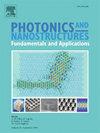Polarization-dependent direct laser nanostructuring of halide perovskites
IF 2.9
3区 物理与天体物理
Q3 MATERIALS SCIENCE, MULTIDISCIPLINARY
Photonics and Nanostructures-Fundamentals and Applications
Pub Date : 2025-06-03
DOI:10.1016/j.photonics.2025.101408
引用次数: 0
Abstract
Laser ablation of halide perovskites is a powerful tool for precise nanopatterning and formation of various nanophotonic designs supporting unique optical properties or lasing. In this study, we investigate the polarization-dependent effects in femtosecond laser ablation of halide perovskites, providing experimental evidence of their non-symmetrical nanostructuring. Through systematic analysis supported by optical simulations, we demonstrate that the shape of the ablated craters evolving under multi-pulse irradiation exhibits a pronounced dependence on the laser polarization, leading to anisotropic material removal. Our simulations and experiments also reveal that the asymmetric energy deposition due to local redistribution of the absorbed laser energy profile plays a critical role during surface scanning by the laser beam, affecting the resulting track morphology. As a result, we justify the optimal nanostructuring regimes allowing the quasi-uniform and gear-shaped perovskite microdisks to imprint upon them supporting low-threshold lasing upon optical excitation. Our findings provide new insights into laser-matter interactions in halide perovskites and open possibilities for controlled laser nanostructuring of optoelectronic materials.
依赖偏振的卤化物钙钛矿直接激光纳米结构
卤化物钙钛矿的激光烧蚀是精确的纳米图案和形成各种纳米光子设计的有力工具,支持独特的光学性质或激光。在本研究中,我们研究了飞秒激光烧蚀卤化物钙钛矿的极化依赖效应,为其非对称纳米结构提供了实验证据。通过光学模拟支持的系统分析,我们证明了在多脉冲辐照下,烧蚀坑的形状演变对激光偏振有明显的依赖性,导致材料的各向异性去除。我们的模拟和实验还表明,由于吸收的激光能量分布的局部重新分布而导致的不对称能量沉积在激光束扫描表面时起着至关重要的作用,影响了所得到的轨迹形貌。因此,我们证明了最佳的纳米结构制度,允许准均匀和齿轮状的钙钛矿微盘在其上压印,支持在光激发下的低阈值激光。我们的发现为卤化物钙钛矿中的激光-物质相互作用提供了新的见解,并为光电材料的受控激光纳米结构开辟了可能性。
本文章由计算机程序翻译,如有差异,请以英文原文为准。
求助全文
约1分钟内获得全文
求助全文
来源期刊
CiteScore
5.00
自引率
3.70%
发文量
77
审稿时长
62 days
期刊介绍:
This journal establishes a dedicated channel for physicists, material scientists, chemists, engineers and computer scientists who are interested in photonics and nanostructures, and especially in research related to photonic crystals, photonic band gaps and metamaterials. The Journal sheds light on the latest developments in this growing field of science that will see the emergence of faster telecommunications and ultimately computers that use light instead of electrons to connect components.

 求助内容:
求助内容: 应助结果提醒方式:
应助结果提醒方式:


